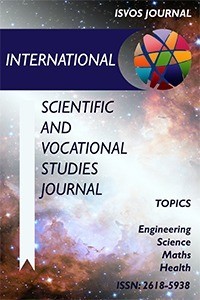Fall Detection Systems Supported by TinyML and Accelerometer Sensors: An Approach for Ensuring the Safety and Quality of Life of the Elderly
Micro Learning, Edge Computing, Cloud Computing, Elderly Fall Detection
Fall Detection Systems Supported by TinyML and Accelerometer Sensors: An Approach for Ensuring the Safety and Quality of Life of the Elderly
Micro Learning, Edge Computing, Cloud Computing, Elderly Fall Detection,
___
- [1] Cyrus Cooper et al. “Frailty and sarcopenia: definitions and outcome parameters”. Osteoporosis International 23 (2012), pp. 1839–1848.
- [2] Yueng Santiago Delahoz and Miguel Angel Labrador. “Survey on fall detection and fall prevention using wearable and external sensors”. Sensors 14(10) (2014), pp. 19806–19842.
- [3] Ozge Dokuzlar et al. “Factors that increase risk of falling in older men according to four different clinical methods”. Experimental aging research 46(1) (2020), pp. 83–92.
- [4] Glenn Forbes, Stewart Massie, and Susan Craw. “Fall prediction using behavioural modelling from sensor data in smart homes”. Artificial Intelligence Review 53(2) (2020), pp. 1071–1091.
- [5] Debra Houry et al. “The CDC Injury Center’s response to the growing public health problem of falls among older adults”. American journal of lifestyle medicine 10(1) (2016), pp. 74–77.
- [6] Weidong Min et al. “Human fall detection based on motion tracking and shape aspect ratio”. Int. J. Multimedia Ubiquitous Eng. 11(10) (2016), pp. 1–14.
- [7] World Health Organization, World Health Organization. Ageing, and Life Course Unit. WHO global report on falls prevention in older age. World Health Organization, 2008.
- [8] Anita Ramachandran and Anupama Karuppiah. “A survey on recent advances in wearable fall detection systems”. BioMed research international 2020 (2020).
- [9] Ramon Sanchez-Iborra and Antonio F Skarmeta. “Tinyml-enabled frugal smart objects: Challenges and opportunities”. IEEE Circuits and Systems Magazine 20(3) (2020), pp. 4–18.
- [10] Mahadev Satyanarayanan. “The emergence of edge computing”. Computer 50(1) (2017), pp. 30–39.
- [11] Ygor Rebouças Serpa et al. “Evaluating pose estimation as a solution to the fall detection problem”. In: 2020 IEEE 8th International Conference on Serious Games and Applications for Health (SeGAH). 2020, pp. 1–7.
- [12] Andrew Sixsmith and Neil Johnson. “A smart sensor to detect the falls of the elderly”. IEEE Pervasive computing 3(2) (2004), pp. 42–47.
- [13] Frank Sposaro and Gary Tyson. “iFall: an Android application for fall monitoring and response”. In: 2009 Annual International Conference of the IEEE Engineering in Medicine and Biology Society. 2009, pp. 6119–6122.
- [14] George E Stelmach and Charles J Worringham. “Sensorimotor deficits related to postüral stability: implications for falling in the elderly”. Clinics in geriatric medicine 1(3) (1985), pp. 679–694.
- [15] Erik E Stone and Marjorie Skubic. “Unobtrusive, continuous, in-home gait measurement using the Microsoft Kinect”. IEEE Transactions on Biomedical Engineering 60(10) (2013),pp. 2925–2932.
- [16] Vavoulas George et al. The MobiFall Dataset: Fall Detection and Classification with a Smartphone. Int. J. Monit. Surveill. Technol. Res. 2014;2:44–56. doi: 10.4018/ijmstr.2014010103.
- [17] Medrano Carlos et al. Detecting Falls as Novelties in Acceleration Patterns Acquired with Smartphones. PLoS ONE. 2014;9:e94811. doi: 10.1371/journal.pone.0094811.
- [18] Frank Korbinian et al. Bayesian Recognition of Motion Related Activities with Inertial Sensors; Proceedings of the 12th ACM International Conference on Ubiquitous Computing (UbiComp); Copenhagen, Denmark. 26–29 September 2010; pp. 445–446.
- [19] Vilarinho Thomas et al. A combined smartphone and smartwatch fall detection system; Proceedings of the IEEE International Conference on Computer and Information Technology; Ubiquitous Computing and Communications; Dependable, Autonomic and Secure Computing; Pervasive Intelligence and Computing; Liverpool, UK. 26–28 October 2015.
- [20] Warden, Pete, and Daniel Situnayake. Tinyml: Machine learning with tensorflow lite on arduino and ultra-low-power microcontrollers. O'Reilly Media, 2019.
- [21] A. Tahir et al. “Hardware/Software Co-Design of Fractal Features Based Fall Detection System,” Sensors, vol. 20, no. 8, p. 2322, Apr. 2020, doi: 10.3390/s20082322.
- ISSN: 2618-5938
- Yayın Aralığı: Yılda 2 Sayı
- Başlangıç: 2017
- Yayıncı: Umut SARAY
Özgür ALPARSLAN, Ebru SOLMAZ, Ayşe ÇATALOLUK
The Role of Sustainable Forest Management in Achieving Land Degradation Neutrality Target
Özlem YAVUZ, Pınar TOPÇU, Ahmet TOLUNAY
Numerical Study on Free Particle Reinforced Fiber-Metal Composite Sandwiches Under Ballistic Loads
Umut CALİSKAN, Nisanur DUMAN, Arslan Talha TERME, Mustafa ÇAYIR, Mürüvvet BOZKURT
Ahmet TOLUNAY, Omer Faruk EKEMEN
Effects of Additives on Concrete-Rebar Adherence
Kemal Tuşat YÜCEL, Kemal Muhammet ERTEN
Investigation of Soil Pollution with Pollution Parameters (Erzurum-Moryayla)
